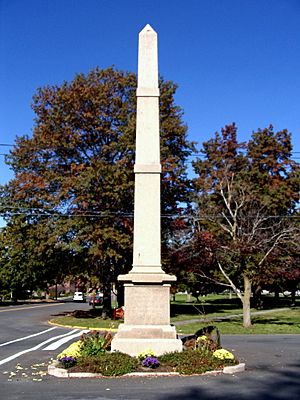Henry Wisner facts for kids
Henry Wisner (born around 1720 – died March 4, 1790) was an important leader during the American Revolution. He was a miller from Goshen, New York, and is considered one of America's Founding Fathers. He played a big part in creating the Declaration of Independence by voting for independence on July 4, 1776. He also represented New York in the Continental Congress, where he signed the 1774 Continental Association.
Contents
Early Life and Beginnings
Henry Wisner was born around 1720 in Florida, New York. He lived in Orange County. He built and ran a gristmill (a mill for grinding grain) in Goshen. This made him one of the most important people in his town. His family came to America in the 1710s from Switzerland.
Serving His Community
Wisner began his political journey in 1759. The people of Orange County chose him to represent them in the Province of New York Assembly. He served there for eleven years in a row! In 1768, he also became a judge in the county court.
Leading During the American Revolution
When New York started its own revolutionary government in 1775, Henry Wisner was chosen to be a delegate. He was sent to both the First and Second Continental Congresses. He served there through 1776.
He was present on July 4, 1776, and voted for America's independence. This was a huge moment in history! Even though he wasn't there to sign the Declaration of Independence later in August, his vote was very important.
While in Congress, Wisner learned that George Washington's army needed a lot of gunpowder and bullets. When he went home, he built three gunpowder mills in New York. These mills made a lot of gunpowder! At their busiest, he sent 1,000 pounds of gunpowder every week to Washington's army. He also helped pay for cannons and defenses along the Hudson River. These defenses were built to stop the British from using the river.
In late 1776, Wisner helped plan a clever defense. He worked with others to measure the Hudson River's depth. They recommended placing a giant chain across the river. This chain, known as the Great Chain, stretched from West Point to Constitution Island. It was designed to block British ships from moving up the Hudson River.
In 1777, Wisner helped write the first constitution for the state of New York. After that, he served as a member of the state senate from 1777 to 1782.
After the War
Even after the war ended, Henry Wisner stayed active in public life. In 1784, he helped start an academy (a school) in Goshen. He also served as a regent for the University of the State of New York for a few years.
In 1788, Wisner was a delegate to a special meeting in New York. This meeting was to decide if New York would approve the new U.S. Constitution. Wisner was one of the people who worried that a very strong central government might take away rights from states and individuals.
Family Life
Henry Wisner married Sarah Norton in 1739. His son, Gabriel, was born in 1754 and sadly died in 1779 during the Battle of Minisink. His daughter, Sarah Wisner, married Major Moses Phillips. Moses Phillips helped Henry Wisner make gunpowder for George Washington's army.
Henry Wisner passed away at his home in Goshen in 1790. He was buried in the Old Wallkill Cemetery in Wallkill, New York.


